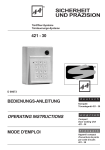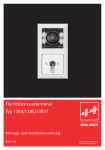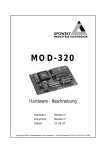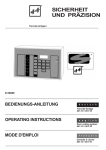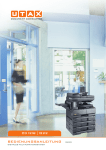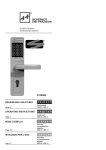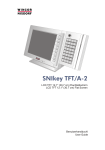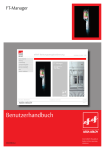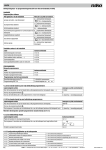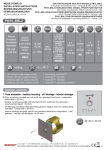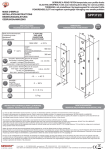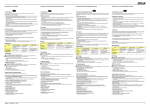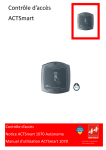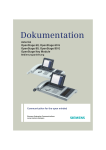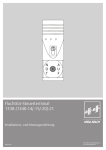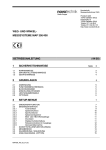Download din en iso 9001 sicherheit und präzision
Transcript
® SICHERHEIT UND PRÄZISION Elektro-Türöffner Türsteuerungs-Systeme ® DIN EN ISO 9001 ® D 0006801 BEDIENUNGS-ANLEITUNG d e u t s c h Türcode-Anlage 430 - 10 OPERATING INSTRUCTIONS e n g l i s h Door Coding System 430 - 10 MODE D'EMPLOI f r a n ç a i s Système d'ouverture de porte par code d'accès 430 -10 ® SICHERHEIT UND PRÄZISION Elektro-Türöffner Türsteuerungs-Systeme d e u t s c h Türcode-Anlage 430 - 10 e n g l i s h Door Coding System 430 - 10 f r a n ç a i s Système d'ouverture de porte par code d'accès 430 - 10 Inhalt Allgemeine Beschreibung Die Tastaturen Die Türöffner Externe Türöffner-Taster Funktionsschalter Codestellen-Wahlschalter Einstellung der Türentriegelungs-Zeit Einstellung der Falschcoderelais-Anzugszeit Externe Störeinflüsse – Reset-Taste Technische Daten Elektroinstallationen Anschlußpläne Seite 3 3 3 3 4 4 4 4 5 5 5 12 Contents: General description Keypads Door releases External door release push-buttons Function switches Code digit selection switches Setting the door unlocking period Setting the erroneous code relay - reaction period External noise influences - reset key Technical specifications Electrical wiring Connection diagram Page 6 6 6 7 7 7 7 7 8 8 8 13 Sommaire : Description générale Clavier Gâche Boutons-poussoir Sélecteurs de mode (switch) Selecteur pour longeur du code Réglage du temps de déverrouillage Réglage du temps d’excitation du relais de faux code Influences perturbatrices externes - Reset Caractéristiques techniques Installation électrique Plan de raccordement Page 9 9 9 10 10 10 10 10 11 11 11 14 d e u t s c h Türcodeanlage 430 - 10 Das vollelektronische / mikroprozessorgesteuerte Türcodesystem Modell 430-10 in Einkanal-Ausführung bietet die Anschlußmöglichkeit für eine Tür (Türöffner) und eine Tastatur. Das Steuergerät beinhaltet in einem stabilen Stahlblechgehäuse die Türcodeelektronik und das Netzteil. Durch eine abschließbare Fronttür ist das Steuergerät vor Manipulationen unberechtigter Personen geschützt. Die Tastatur wird üblicherweise im Handbereich der Tür, und das Steuergerät im geschützten Bereich innerhalb des Gebäudes, montiert. Der Elektro-Türöffner wird als Gegenstück zum Türschloß in den Türrahmen eingebaut. 3405 RR/3705 RR (Ruhestromfunktion). Es wird grundsätzlich empfohlen, Türöffner mit Rückmeldekontakten (Bestellzusatz RR) zu verwenden. Die elektrische Leitungsverbindung von der Türcodeanlage zum Elektro-Türöffner muß mit abgeschirmter Installationsleitung erfolgen. Türöffner mit Arbeitsstromfunktion: Der Arbeitsstrom-Türöffner z.B. 1405 RR ist mit Spannung entriegelt. Bei Stromausfall bleibt die Verschlußsicherheit der Tür gewährleistet. Türöffner mit Ruhestromfunktion: Der Ruhestrom-Türöffner z.B. 3405 RR ist ohne Spannung entriegelt. Bei Stromausfall ist die Tür für jeglichen Zutritt frei. Funktion Sicherheits-Türöffner Die am Tastgerät eingegebene 4-stellige Codezahl wird in elektrische Signale umgesetzt und an das Steuergerät weitergegeben. Hier wird durch Vergleich der Signale mit der vorgegebenen Codezahl über die Zutrittsberechtigung entschieden. Ist diese positiv, schaltet das Türöffner-Ausgangsrelais für eine im Steuergerät voreingestellte Zeit (Türentriegelungszeit), die Tür frei. Die 4-stellige Codezahl kann jederzeit an den 4 Codeschaltern, die auf der Hauptplatine angeordnet sind, verändert werden. Bei erhöhten Sicherheitsanforderungen empfiehlt sich der Einbau der Sicherheits-Türöffner Modell 14105 RR (Arbeitsstrom) oder Modell 341055 RR (Ruhestrom). Diese Sicherheits- Türöffner haben eine Druckfestigkeit >15 KN gegen Aufbruchversuche. Die Tastaturen Technische Daten 1405 RR Nennspannung 12 V(Spannungstoleranz 11 - 13 V-) Stromaufnahme 200 mA, 100% ED 1705 RR Nennspannung 12 V(Spannungstoleranz 11 - 13 V-) Stromaufnahme 230 mA, 100% ED 3405 RR Nennspannung 12 V(Spannungstoleranz 11 - 13 V-) Stromaufnahme 200 mA, 100% ED 3705 RR Nennspannung 12 V(Spannungstoleranz 11 - 13 V-) Stromaufnahme 230 mA, 100% ED 14105 RR Nennspannung 12 V (Spannungstoleranz 11 - 13 V-) Stromaufnahme 400 mA, 100% ED 34105 RR Nennspannung 12 V(Spannungstoleranz 11 - 13 V-) Stromaufnahme 470 mA, 100% ED Allgemeine Beschreibung Tastaturen werden stets im Handbereich der Türen montiert. Nach dem Abschrauben und Abnehmen der Frontplatte kann man das Tastaturgehäuse bequem installieren. Das Einführen und Anschließen der 7-adrigen, abgeschirmten Steuerleitung (siehe Anschlußschaltbild), ist jetzt möglich. Beim anschließenden Wiederaufschrauben der Frontplatte, muß bei wassergeschützten Tastaturen darauf geachtet werden, daß die Dichtung nicht beschädigt wird. Als Tastatursteuerkabel ist mindestens eine 7-adrige, abgeschirmte Leitung erforderlich. Die maximale Leitungslänge zwischen Tastatur und Steuergerät darf 200 m nicht überschreiten. Von der Türcodeanlage aus müssen sämtliche Leitungen separat verlegt werden. Es stehen verschiedene Tastgeräte zur Auswahl. Ihnen allen ist gemeinsam, daß sie eine 12er Matrixtastatur besitzen. Im Einzelnen sind folgende Tastaturen lieferbar: 412-12 -Tastgerät-Aufputzausführung, 413-12 -Tastgerät-Aufputz, wassergeschützt, 414-12 -Tastgerät-Unterputzausführung, 415-12 -Tastgerät-Unterputz, wassergeschützt Die Türöffner Die mit der Türcodeanlage einzusetzenden Türöffner sind die Modelle 1405 RR/1705 RR (Arbeitsstromfunktion) und Türöffner mit Rückmeldekontakten Bestellzusatz „RR“ Automatisches Rücksetzen des Türöffnerrelais bei aufgemachter Tür. Somit ist die anschließend zugemachte Tür sofort wieder verriegelt. Externe Türöffnertaster Mittels bauseitiger bzw. externer Türöffnertaster kann die Tür in gewohnter Weise von innen geöffnet werden. Der Türöffner wird dann über die voreingestellte Türentriegelungszeit (Funktionsdrehschalter Türentriegelungszeit) entriegelt. 3 d e u t s c h Türcodeanlage 430 - 10 Funktionschalter (Schiebeschalter 1-3) Schiebeschalter 1: Dauerentriegelung/Kurzzeitentriegelung Variante A: Schiebeschalter 1-on- (oben) Kurzzeitentriegelung (werkseitige Einstellung). Nach Eingabe der richtigen Codezahl, entriegelt der Elektro- Türöffner für die am Funktionsdrehschalter (Türentriegelungszeit) eingestellte Türentriegelungszeit. Variante B: Schiebeschalter 1-off-(unten) Dauerentriegelung. Durch das Betätigen der Plus-Taste und anschliessendes Eingeben der richtigen Codezahl an der Tastatur, kann die Tür dauerentriegelt werden. Somit besteht die Möglichkeit, diese Tür beliebig oft zu begehen. Zum Wiederverriegeln der Tür muß an der Tastatur zunächst die Minus-Taste und dann die Codezahl eingegeben werden. Wird die PlusTaste an der Tastatur nicht betätigt, ist bei Eingabe der richtigen Codezahl die Grundfunktion (Kurzzeitentriegelung) wirksam. Schiebeschalter 2: Normalbetrieb/Testbetrieb Variante A: Schiebeschalter 2-on-(oben) Normalbetrieb (werkseitige Einstellung). Wie der Name Normalbetrieb aussagt, sind hierbei die Standardfunktionen wie in der Beschreibung Kurzzeit- bzw. Dauerentriegelung wirksam. Variante B: Schiebeschalter 2-off-(unten) Testbetrieb. Bei dieser Funktion können die Zifferntafeln des Tastgerätes sowie die Tastgerätsteuerleitung auf ordnungsgemäße Funktion überprüft werden. Bei jeder Ziffernbetätigung am Tastgerät wird das Türöffnerrelais (Elektro-Türöffner) angesteuert. Die Plus- bzw. Minus-Taste am Tastgerät arbeitet nach dem gleichen Testmodus, jedoch wird hierbei der Rückmeldekontakt des Türöffners noch zusätzlich auf Durchgang geprüft (Türstellung für Testbetrieb-Tür zu). Sollte ein Elektro- Türöffner ohne Rückmeldekontakt verwendet werden, wird hierbei die richtige Grundeinstellung des Schiebeschalters 3 geprüft. Falsche Gerätegrundeinstellung, falscher Anschluß, sowie defekte Tastgerätsteuerkabel und Funktionsfehler des Türöffnerrückmeldekontaktes können durch diesen Testmodus lokalisiert werden. 4 Schiebeschalter 3: Elektro-Türöffner mit Rückmeldekontakt RR/ Elektro-Türöffner ohne Rückmeldekontakt RR Variante A: Schiebeschalter 3-on (oben) Anschluß eines Elektro-Türöffners ohne Rückmeldekontakt RR Variante B: Schiebeschalter 3-off (unten) Anschluß eines Elektro-Türöffners mit Rückmeldekontakt RR (werkseitige Einstellung) Einstellung der Türentriegelungszeit "Funktionsdrehschalter Türentriegelungszeit" Auf der Anschlußplatine der Türcodeanlage befindet sich ein Drehschalter, der zur Einstellung der Türentriegelungszeit dient. Diese Einstellung bestimmt die Zeit, in der die Tür geöffnet werden kann, nachdem die richtige Codezahl eingegeben wurde. Raster 1 Teilstrich = 2 Sek. Türentriegelungszeit (max. 30 Sek. einstellbar) Bei Verwendung von Türöffnern mit Rückmeldekontakten RR (Funktionsschalter, Schiebeschalter auf Stellung 3-off), wird die Türentriegelungszeit nach einmaliger Begehung zurückgestellt. Einstellung der Falschcoderelais-Anzugszeit ”Funktionsdrehschalter Falschcoderelais-Anzugszeit” Mit der Funktion Falschcodeauswertung wird das Herausfinden der richtigen Codezahl durch ”Probieren” erschwert. Werden mehr als 5 falsche Codezahlen (20 Ziffern) eingegeben, zieht das Falschcoderelais (potentialfreier Relaiskontakt) für die am Funktionsdrehschalter voreingestellte Zeit an. Zusätzlich wird die Tastatur während der Anzugszeit des Falschcoderelais gesperrt. Die Eingabe der richtigen Codezahl ist erst nach Ablauf der eingestellten Zeit möglich. Weitere Versuche sind dadurch sinnlos geworden. Der Funktionsdrehschalter für die Falschcoderelais - Anzugszeit befindet sich auf der Anschlußplatine der Türcodeanlage. Raster 1 Teilstrich = 6 Sek. Türcoderelais-Anzugszeit (max.90 Sek. einstellbar) d e u t s c h Türcodeanlage 430 - 10 Externe Störeinflüsse - Reset - Taster Technische Daten: Trotz interner Schutzmaßnahmen können außergewöhnlich starke Störfelder eine Störung der mikroprozessorgesteuerten Türcodeanlage herbeiführen. Störeinflüsse können verhindert werden, wenn bei der Installation folgende Punkte beachtet werden: Anschlußspannung 230 V WS +10%/-10% Frequenz 50 - 60 Hz Leistungsaufnahme max. 21 W Betriebsnennspannung 12 V max. Belastbarkeit 600 mA für externe Verbraucher (z.B. Türöffner) Schutzart IP 20 Betriebstemperatur 00 C bis 400 C – Gerät nicht in unmittelbarer Nähe von induktiven Verbrauchern montieren – Separate Leitung für Netzspannungs versorgung verlegen ( evtl. Netzfilter ). – Induktive Verbraucher entstören (Varistor, RC-Glied) Nach Störungsbeseitigung ist die Neuinbetriebnahme (Reset) der Türcodeanlage erforderlich. Hierzu muß der Reset-Taster, der sich auf der Hauptplatine befindet, gedrückt werden, bis die danebenliegende gelbe LED kurz aufleuchtet. Eingänge: 1 Netzanschluß mit Schutzleiter 1 Tastgerät (7-polig) 1 Türöffner mit Rückmeldekontakten 1 Türöffner- Taster Ausgänge: 1 Elektro- Türöffner (Relais mit potentialfreiem Wechselkontakt) 1 Falschcoderelais (Relais mit potentialfreiem Wechselkontakt) Alle Relaiskontakte sind mit max. 65 V/2 A belastbar. ® Elektro-Installation Geschützter Bereich (innen) abgeschirmt 8 max 200 m 430 - 10 ~ – Tastgerät 7 4 1 + 4 abgeschirmt 8 5 2 0 9 6 3 – 2 abgeschirmt Elektro-Türöffner Türöffner-Taster 3 230 V / 50 - 60 Hz 2 NYM 3 x 1,5 mm 5 e n g l i s h Door Coding System 430 - 10 General description The fully electronic/microprocessor-controlled door coding system model 430-10 in the single channel version provides facilities for the connection of one door (door release) and one keypad. Residing in a robust sheet steel enclosure the control device comprises the door coding electronics and the power unit. The control device is protected against manipulation by unauthorized persons by means of a lockable front door. The keypad is usually mounted within hand reach of the door and the control device in the protected area inside the building. The electric door release is fitted into the door frame in the form of a counterpart to the door lock. Function: The 4-digit code number entered via the keypad are converted into electrical signals and passed on to the control device. There it is decided as to access entitlement by comparing the signals with the prespecified code number. If this is positive the door release output relay will switch to release for a time period (door unlocking period) that has been preset in the control device. The 4-digit code number can be altered at any time using the 4 code switches arranged on the main circuit board. Keypads Keypads are always mounted within hand reach of doors. The keypad enclosure can be conveniently fitted by unscrewing and removing the front panel. Introduction and connection of the 7-conductor screened control cable (see connection diagram) is now possible. When the front panel is subsequently screwed back on, in the case of keypads protected against water, care must be taken that the seal is not damaged. Screened cable with a minimum of 7 conductors is required to be used for the keypad control cable. A lead length between keypad and control device of 200 m may not be exceeded. Outgoing from the door coding system all leads must be laid separately. A choice of several different keypad units is available. Common to all is that they have a 12-key matrix keypad. In detail the following keypads are available: 412-12 keypad unit - surface mounted version 413-12 keypad unit - surface mounted, protected against water 414-12 keypad unit - concealed mounting 415-12 keypad unit - concealed mounting, protected against water 6 Door releases The door releases to be utilized together with the door coding system are the models 1405 RR/1705 RR (energized mode) and 3405 RR/3705 RR (nonenergized mode). It is recommended fundamentally that the door release be used together with check-back position indicator contacts (ordering suffix RR). The electrical lead connection between the door coding system and the electrical door release must be effected using screened cable. Door release in energized mode: The energized mode door release, e.g. 1405 RR, is unlocked when under voltage. In the event of a power failure the locking security of the door is guaranteed. Door release in nonenergized mode: The nonenergized mode door release, e.g. 3405 RR, is unlocked when not under voltage. In the event of a power failure the door provides absolutely free access. Security door release In the case of enhanced security requirements it is recommended that security door release model 14105 RR (energized mode) or 34105 RR (nonenergized mode) be fitted. These security door releases have a pressure resistance of > 15 KN to break-in attempts. Door release with check-back position indicator contacts, ordering suffix ...RR Automatic resetting of the door release relay when the door is opened. Thus the subsequently closed door is immediately relocked. Technical specifications: 1405 RR voltage rating 12 V (voltage tolerance 11 - 13 V) power consumption 200 mA, continuous duty 1705 RR voltage rating 12 V (voltage tolerance 11 - 13 V) power consumption 230 mA, continuous duty 3405 RR voltage rating 12 V (voltage tolerance 11 - 13 V) power consumption 200 mA, continuous duty 3705 RR voltage rating 12 V (voltage tolerance 11 - 13 V) power consumption 230 mA, continuous duty 14105 RR voltage rating 12 V (voltage tolerance 11 - 13 V) power consumption 400 mA, continuous duty 34105 RR voltage rating 12 V (voltage tolerance 11 - 13 V) power consumption 470 mA, continuous duty e n g l i s h Door Coding System 430 - 10 External door release keys The door can be opened in the usual way from internal rooms by means of door release keys provided on site or externally. The door release is then unlocked via the preset door unlocking period (rotary function switch for door unlocking period). Function switches (sliding switches 1-3) Sliding switch 1: continuous unlocking/short period unlocking Variation A: Sliding switch 1 -on- (at top) short period unlocking (setting ex-works). After input of the correct code number the electric door release unlocks for the door unlocking period set via the rotary function switch (door unlocking period). Variation B: Sliding switch 1 -off- (at bottom) continuous unlocking . The door can be continuously unlocked by actuating the plus key and subsequent entry of the correct code number via the keypad. The possibility thus exists of accessing this door with random frequency. In order to relock the door first of all the minus key and then the code number have to be entered at the keypad. If the plus key is not actuated on the keypad the basic function (short period unlocking) is effective upon entry of the correct code number. Sliding switch 2: 1 Normal mode/test mode Variation A: Sliding switch 2 -on- (at top) normal mode (setting ex-works). As the name suggests, in this case the standard functions are effective as in the description short period or continuous unlocking. Variation B: Sliding switch 2 -off- (at bottom) test mode . With this function the numeric keys on the keypad and the keypad control line can be verified as to orderly functioning. The door release relay (electric door release) is driven upon each numeral actuation on the keypad. The plus or minus keys on the keypad function in test mode in the process, however, the door release’s check-back position indicator contact is tested additionally for connection (door position for test mode - door closed). If an electric door release without check-back position indicator is being used, the correct basic setting of the sliding switch3 is verified in the process. An erroneous basic setting, a wrong connection, defective keypad control cable or functional error of the door release check-back position indicator contact can be localized by means of this test mode. Sliding switch 3: electric door release with check-back position indicator contact RR electric door release without check-back position indicator contact RR Variation A: Sliding switch 3 -on (at top) connection of an electric door release without check-back position indicator contact RR Variation B: Sliding switch 3 -off (at bottom) connection of an electric door release with check-back position indicator contact RR (setting ex-works) Setting of the door unlocking period "Rotary function switch for door unlocking period". A rotary switch is located on the connection board of the door coding system, the purpose of which is the setting of the door unlocking period. This setting determines the time period during which the door can be opened after the correct code number has been entered. Graduation 1 increment = 2 secs. door unlocking period (settable to 30 secs. max.) If door releases with check-back position indicator contacts RR (function switch, sliding switch in position 3 -off-) are being used, the door unlocking period is reset after a single access. Setting of the erroneous code relay - reaction period "Rotary function switch erroneous code relay reaction period" Ascertaining the correct code number by "trial and error" is made more difficult by the erroneous code evaluation function. If more than 5 erroneous code numbers (in the case of a 4-digit code number 20 numbers, in the case of a 6-digit code number 30 numbers) are entered, the erroneous code relay (zero potential relay contact) reacts for the time preset via the rotary function switch. In addition the keypad is disabled during the reaction time of the erroneous code relay. Entry of the correct code number is not possible until the preset time period has expired. Further "attempts" will therefore be pointless. The rotary function switch for the erroneous code relay reaction time is located on the connection board of the door coding system. Graduation 1 increment = 6 secs. door code relay reaction time (settable to 90 secs. max.) 7 e n g l i s h Door Coding System 430 - 10 External noise influences - reset key Technical specifications: Despite internal proofing measures exceptionally strong noise fields can bring about a malfunction of the microprocessor-controlled door coding system. Noise influences can be prevented if the following points are heeded during installation: Connected voltage Frequency Power consumption Operating voltage Load capacity 230 V AC + 10 % / - 10 % 50 - 60 Hz 21 W max. 12 V 600 mA max. for external power consumers (e.g. door releases) Degree of protection IP 20 Operating temperature 0 °C to 40 °C – Do not mount the unit in the immediate vicinity of inductive power consumers. – Lay a separate line for mains voltage supply (possibly using a mains filter) . – Suppress any inductive power consumers (varistors, RC-sections). After elimination of the noise, resetting of the door coding system is necessary. For this purpose the reset key, which is located on the main board, has to be pressed until the adjacent yellow LED illuminates briefly. Inputs: 1 mains connection with earth lead 1 keypad unit (7-pole) 1 door release with check-back position indicator contacts 1 door release push-button Outputs: 1 electric door release (relay with zero potential alternating contact) 1 erroneous code relay (relay with zero potential alternating contact) All relay contacts can be subjected to a maximum load of 65 V/2 A. ® Protected zone (inside) Electrical Wiring keypad unit 8 screened 200 mtrs max. 430 - 10 ~ – 4 screened 2 7 4 1 + 8 5 2 0 9 6 3 – screened electric door release door release push-button 3 230 V / 50 - 60 Hz 2 NYM 3 x 1,5 mm 8 f r a n ç a i s Centrale à clavier digital 430 - 10 Descripton générale Gâche fonctionnant en courant de travail La centrale à clavier digital 430-10 est commandée par un microprocesseur, qui lui permet de gérer l´accès d´une porte (centrale 1 porte). Autrement dit, elle peut être reliée à une gâche et â un clavier à touches numériques. Abritée dans un boîtier métallique robuste, la centrale comprend l’électronique de commande et le bloc d‘alimentation. Une porte frontale, fermée à clé, la protége contre toute inter- vention de la part de personnes non autorisées. La gâche fonctionnant en courant de travail, par ex. 1405 RR, est déverrouillée sous tension, le verrouillage restant ainsi garanti en cas de rupture de courant. La centrale est installée généralement dans un endroit protégé, à l‘intérieur du bâtiment, alors que le clavier à touches numériques l‘est à proximité immédiate de la porte dont il doit gérer l‘accès. La gâche électrique adéquate est montée dans le chambranle. Fonctionnement Le coe à 4 chiffres tapés sur le clavier sont convertis en signaux électriques et transmis au système de commande qui les compare aux chiffres programmés. Si le code est identifié, l‘accès est autorisé et le relais de la gâche se libère pendant une durée enregistrée au préalable dans la centrale de commande (temps de déverrouillage de la porte). Le code à 4 chiffres peut être modifié à tout moment sur les 4 interrupteurs de codage qui trouvent sur la platine principale. Clavier Le clavier est à installer à proximité de la porte. Retirer la plaque frontale pour pouvoir le fixer sans problèmes et mettre en place le câble de commande à 7 fils avec écran (voir schéma de connexion). Dans le cas d‘un clavier en version étanche, veiller à ne pas détériorer le joint au moment de la remise en place de la plaque frontale. Pour relier le clavier à la centrale, le minimum requis est un câble à 7 fils avec écran. Sa longueur ne doit pas excedér 200 m. Chaque câble quittant la centrale est à poser de facon distincte. Nous proposons les claviers ci-dessous qui ont tous en commun une configuration matricielle de 12 touches; Claviers disponibles: Clavier 412-12 - version en saillie Clavier 413-12 - version en saillie et étanche Clavier 414-12 - version encastrée Clavier 415-12 - version encastrée et étanche Gâche La centrale à clavier digital 430-10 implique l‘utilisation d‘une gâche parmi les modèles suivants: 1405 RR/1705 RR (courant de travail) ou bien 3405 RR/3705 RR (courant de repos). On recommande en principe l‘emploi d‘une gâche à contact de fond de pêne (suffixe de référance: RR). Gâche fonctionnant en courant de repos La gâche fonctionnant en courant de repos, par ex. 3405 RR, est deverrouillée en l‘absence de courant, ce qui signifie qu‘en cas de rupture de l‘alimentation électrique, la porte est libérée et peut être franchie à tout moment. Gâche de sécurité Lorsqu‘il convient de mettre en place des mesures de sécurité renforcées, il est préférable d'utiliser une gâche de sécurité 14105 RR (courant de travail) ou 34105 RR (courant de repos). Ces gâches peuvent resister aux tentatives d‘effraction jusqu‘à des forces > 15 kN. Gâche avec contact de fond de pêne, suffixe de référence: RR A l‘ouverture de la porte, le relais de gâche se repositionne automatiquement de sorte que la porte refermée immédiatement verrouillée en se refermant. Caractéristiques techniques: 1405 RR Tension nominal 12 V(tension admise: de 11 V â 13 V) Consommation de courant: 200 mA Gâche sous tension permanente 1705 RR Tension nominal 12 V(tension admise: de 11 V à 13 V) Consommation de courant: 230 mA Gâche sous tension permanente 3405 RR Tension nominal 12 V(tension admise: de 11 V à 13 V) Consommation de courant: 200 mA 3705 RR Tension nominal 12 V(tension admise: de 11 V à 13 V) Consommation de courant: 230 mA 14105 RR Tension nominal 12 V(tension admise: de 11 V à 13 V) Consommation de courant: 400 mA Gâche sous tension permanente 34105 RR Tension nominal 12 V(tension admise: de 11 V à 13 V) Consommation de courant: 470 mA 9 f r a n ç a i s Centrale à clavier digital 430 - 10 Bouton-poussoir Un boutton poussoir permet d‘ouvrir normalement la porte de l‘intérieur. La durée de libération de la gâche est alors fonction du temps de déverrouillage programmé (bouton de réglage du temps de déverrouillage). Switch 3 Position ON (en haut): Raccordement d‘une gâche sans contact de fond de pêne Position OFF (en bas): Raccordement d‘une gâche avec contact de fond de pêne (RR) Réglage du temps de verrouillage Sélecteurs de mode (switch 1-3) Switch 1 Position ON ( en haut): Déverrouillage momentané (réglage à l‘usine) Si le code correct a éte composé,la gâche se libère pour la durée programmée sur le bouton de réglage ( du temps de déverrouillage de la porte). Position OFF ( en bas): Déverrouillage permanent Pour obtenir un déverrouillage permanent, presser la touche + et composer le code. La porte peut alors être franchie à loisir. Pour la reverrouiller, presser la touche puis recomposer le code. Switch 2 Position ON (en haut): Mode normal (réglé à l‘usine) Dans ce qu‘on appelle "mode normal", les fonctions activées sont les fonctions standards donnés par le switch 1 Position OFF (en bas): Mode test Cette fonction permet de côntroler le fonctionnement des touches du clavier ainsi que celui du câble de commande. Chaque pression de l‘une des touches numériques du lavier provoque l‘excitation du relais de gâche. La touche +/- réagit de la même facon au mode test, mais avec en supplément un contrôle du relais de gâche (la porte doit être fermée pendant le test). Dans le cas d‘une gâche sans contact de fond de pêne, c‘est alors un contrôle du switch 3 qui a lieu. Ce mode test permet de vérifier le réglage de bas de la central, de détecter un branchement incorrect ou une défectuosité du cable de commande et de localiser toute erreur de fonctionnement au niveau du contact de fond de pêne. 10 La centrale porte un bouton de réglage du temps de déverrouillage de la porte. C‘est le temps pendant lequel la porte est libérée. Il peut être réglé entre 2 et 30 secondes. 1 trait de la graduation = 2 secondes. Dans le cas d‘une gâche „RR„ à contact de fond de pêne (voir schéma électrique), celle-ci est libérée jusqu‘à ce qu‘on ouvre la porte et se retrouve verrouillée dès que la porte se referme, même si la durée programmée n‘est pas encore écoulée totalement. Réglage du temps d’excitation du relais de faux code errone „Commutateur rotatif de réglage du temps d’excitation du relais de code errone“ la fonction de comptage des codes erronés rend plus difficile la violation du numéro de code par „numérotation aléatoire”. Si plus de 5 codes erronés (20 chiffres) ont été composés, le relais de code erroné (contact flottant) est alors excité pour une durée préréglée sur le commutateur rotatif de commande. L’activation du relais de code erroné s’accompagne par ailleurs d’un verrouillage du clavier qui empêche l’introduction du bon code d’acces d’ouverture jusqu’à l’expiration du temps de blocage, rendant ainsi vaine toute „tentative” supplémentaire de violation du code. Trait de graduation = 6 s. Temps d’excitation du relais de code (réglable jusqu’à 90 s. max.) f r a n ç a i s Centrale à clavier digital 430 - 10 Influences perturbatrices externes - Reset Caractéristiques techniques En dépit des mesures de protection internes, des champs parasitaires importants peuvent intervenir et dérégler le système de codage. Un certain nombre de précautions à prendre à l‘installation peuvent mettre la centrale à l‘abri de telles perturbations: Tension et plage d‘alimentation Fréquence Puissance absorbée Tension nominal de fonctionnement Courant maximum disponible pour usagers externes (par ex. gâche) Température de fonctionnement Classe de protection - Ne pas installer la centrale à proximité d‘appareils à induction - Utiliser un câble d‘alimentation secteur séparé (éventuellement, recourir à un filtre secteur) - Antiparasiter les récepteurs inductifs (varistor, circuit RC). 230 V +- 10 % 50/60 Hz 21 W max. 12 V CC 0,6 A 0°c à 40°C IP 20 Entrées: 1 prise secteur avec câble UGV 1 clavier (7 pôles) 1 gâche avec contact de fond de pêne 1 bouton-poussoir Lorsqu‘il y a eu un dérangement, il est nécessaire de réinitialiser le système de codage en faisant un Reset. A cette fin, shunter un bref instant les broches Reset de remise à zéro qui se trouvent sur la platine principale. Sorties: 1 gâche électrique (relais à contact inverseur R.T.C. sec) 1 relais de faux code (relais à contact inverseur R.T.C. sec) Tous les contacts de relais admettent une capacité de charge de 65 V/2 A. ® Installations électriques Zone protégée (intérieur) 430 - 10 ~ – Clavier numérique 8 avec écran max. 200 m 4 avec écran 7 4 1 + 8 5 2 0 9 6 3 – 2 avec écran Gâche électrique Bouton-poussoir 3 230 V / 50 - 60 Hz 2 VGN 3 x 1,5 mm 11 12 Codeschalter Codezahl 4-stellig 1 2 3 4 5 6 7 2 3 0 gelb grün grau blau rot Nennstrom für Elektro-Türöffner max. 0,6 A Arbeitsstromtüröffner (mit RR) 1405.../1705.../14105... 11 12 13 14 15 16 17 18 19 Ruhestromtüröffner (mit RR) 3405.../3705.../34105 Achtung! Bei Verwendung von Türöffnern ohne Rückmeldekontakt Funktionsschalter 3 in Stellung ON rot Schaltbild der Matrixtastaturen 3 2 1 + Türöffnertaster extern 230 V/50 Hz Zentrale Erdanschlußklemme im Gehäuse Kabelschirme auflegen grau blau + 0 – 1 2 3 4 5 6 7 8 9 6 6 7 12 V- L N PE F1 0,25 AT Achtung! Bei Versorgung des Gerätes mit externer Spannung 12 V- darf keine Netzspannung angeschlossen werden 8 9 10 11 12 13 14 15 16 17 18 19 F2 0,63 AT Trafo gelb grün – 9 8 5 4 5 7 4 3 2 1 6 7 Falschcoderelais 5 TÖ-Relais 4 TÖ-Taster 3 Rückmeldekontakt 2 3 12 V- 0,6A 1 Tastatur Schaltstrom max. 2 A 4 1 2 mit RR Testbetr. Dauerentr. Kontaktbelastbarkeit Schaltspannung max. 65 V 1 Türentriegelungszeit Einstellbereich 1 - 30 sec. Drehschalter Falschcoderelais Anzugszeit Einstellbereich 1 - 90 sec. LD 1 (gelb) ON ohne RR Normalbetrieb Kurzzeitentr. Taster Reset Funktionsschalter d e u t s c h Anschlußplan Türcode-Steuergerät 430-10 2 0 + red Circuit diagram of matrix keypads blue 9 grey 230 V/50 Hz Nominal current for electric lock release max. 0,6 A Normally closed lock release (with two monitoring contacts 1405.../1705.../14105... yellow green 8 External door opener push button 12 V- Caution! When supplying the appliance with an external switch no supply voltage can be connected. 9 10 11 12 13 14 15 16 17 18 19 11 12 13 14 15 16 17 18 19 Normally open lock release (with two monitoring contacts 3405.../3705.../34105... Caution! If using lock releases without monitoring contacts slide switch 3 to ON position Earth terminal in the housing shielding red 7 8 L N PE F1 0,25 AT blue – 6 7 6 7 F2 0,63 AT Transformer grey + 0 – 1 2 3 4 5 6 2 1 3 9 6 8 5 4 5 7 4 3 2 1 5 Error code relay 4 door opener relay 3 door opener 2 4 3 monitoring contact 1 Keypad 3 2 with monitoring check out perm. unlocking Contact capacity switching voltage 65 V max. switching current 2 A max. 1 1 12 V- 0,6A yellow green 1 2 3 4 5 6 7 Code switch Code number 4-digit turn switch Time of unlocking setting range 1 - 30 sec. LD 1 (yellow) Error code relay operating time setting range 1 - 90 sec. Push button ON without monitoring normal operating short-time unlocking Reset Control switch e n g l i s h Connection Diagram Controller 430-10 13 14 Composition de code code à 4 repères 1 2 3 4 5 6 7 Temporisation de décondamnation 1 - 30 sec. LD 1(jaune) 2 0 1 + 9 rouge 8 gris bleu 230 V/50 Hz Courant nominal pour gâche 0,6 A max. Gâche électrique travaillant par établissement en courant continu (avec contacts de signalisation) 1405.../1705.../14105... jaune vert 7 Bouton de commande externe 12 VAttention! En cas d'alimentation externe de l'appareil il est impossible de raccorder une tension de résau 9 10 11 12 13 14 15 16 17 18 19 Attention! En cas d'utilisation de gâches électriques dépourvues de contacts de signalisation, l'interrupteur 3 doit être positionné sur "marche" Bornier de mise à la terre 11 12 13 14 15 16 17 18 19 Gâches électriques travaillant par coupure (avec contact de signalisation) 3405.../3705.../ 34105... rouge Schéma de connexion pour les claviers matriciels 8 L N PE F1 0,25 AT gris bleu – 6 7 6 7 relais F2 0,63 AT Transformateur jaune vert + 0 – 1 2 3 4 5 6 6 5 4 3 9 5 8 4 3 2 1 5 7 4 4 Relais pour code erroné 3 3 3 micro- contacts avec contacts de signal. bouton de comm. mise au point décondamn. indéterminée 2 2 1 2 12 V- 0,6A 1 Clavier Capacité de contact tension max. 65 V courant max. 2 A 1 Relais pour code erroné temps d'actionnement range 1 - 90 sec. Commutatuer ON sans contacts de signal. marche normal décondamn. temporaire Bouton poussoir Reset Selecteur de fonction f r a n ç a i s Plan de raccordement Centrale 430-10 ® SICHERHEIT UND PRÄZISION Elektro-Türöffner Türsteuerungs-Systeme SICHERHEIT UND PRÄZISION Das Unternehmen The company L´entreprise effeff effeff - ein starkes und technologie-orientiertes Unternehmen hat ein unverwechselbares, in über 50-jähriger Firmengeschichte gewachsenes Profil. Das Unternehmen, das heute über 700 Mitarbeiter beschäftigt, gilt in seinen Märkten als ein Haus, das Konzeptionen prägt und Richtungen weist. Strenge Orientierung an Zukunfts-Technologien und die konsequente Realisierung technologischer Spitzenlösungen haben effeff zu seiner qualifizierten Marktposition geführt. effeff - a dynamic, techno-logically oriented enterprise whose unmistakable profile is the culmination of over 50 years of successful company history. Today employing a staff of over 700, the company enjoys a reputation in the markets it serves for progressive technological development and trailblazing concepts. It is dedication to the technologies of the future and a consistent record in realizing outstanding solutions which have placed effeff in its qualified market position. Une entreprise à très fort développement technologique qui bénéficie d´une expérience de plus de 50 ans, ce qui lui assure une réputation imcomparable. Plus de 700 ouvriers et cadres s´emploient à faire la réputation de la marque et à respecter les orientations, garanties de leur réussite dans le domaine de la technologie de pointe et d´avenir. Konsequente System-Technik Consistent and systematic engineering Die komplette Lösung aus einer Hand ist klare effeff-Linie. effeff entwickelt und produziert nahezu alle Komponenten im eigenen Hause. So entstehen integrierte und technologisch im Detail aufeinander abgestimmte Lösungen. effeff-Systeme sind richtungsweisende Komplett-Lösungen: die Anlagen sind aus einem Guß. effeff ist heute der führende deutsche Hersteller, ein professioneller, engagierter und anwendungsorientierter Partner. effeff – in mehr als 60 Ländern der Erde ein Markenzeichen für Sicherheit und Präzision. effeff follows a consistent policy of offering complete solution packages. Practically all used components are developed and produced under the company´s own roof, thus offering custumers integrated system solutions coordinated down to the last detail. effeff systems lead the market with complete, open-ended solutions from a single competent source. Today, effeff is the leading producer of electromechanical and electronical security; a committed and professional partner oriented towards practical application. Not only in Germany, but also in Europe! Efficacité des systèmes eff-eff La devise de effeff est de viser une fabrication totalement intégrée pour assurer une évolution constante et une parfaite fiabilité entre les produits dans leur moindre détail technologique. effeff a l´avantage d´offrir des systèmes et des ensembles complets. effeff se trouve à ce jour le leader des fabricants allemands dans son orientation et sa particularité professionnelle. Elektro-Türöffner Türsteuerungs-Systeme DIN EN ISO 9001 ® D0006801 ® effeff – Fritz Fuss GmbH & Co. Elektrotechnische Fabrik Postfach 490 D 72425 Albstadt Telefon 074 31 . 123 - 0 Telefax 074 31 . 123 240 oder 123 303 Telex 763 731 ffus d ©'91/94/95 PRINZ/PARTNER D 72379 Hechingen – Printed in Germany ®
















